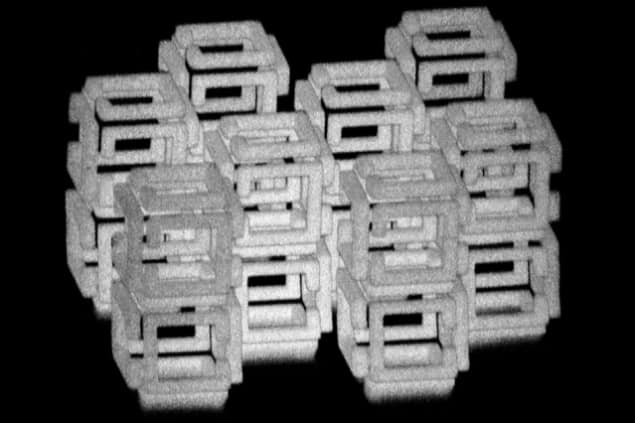Imploding hydrogel shrinks objects to the nanoscale
14 Dec 2018 Belle Dumé
A new 3D nanofabrication technique called Implosion Fabrication could be used to create a wide variety of nano- and microstructures not previously possible. The technique, which can print 3D objects of nearly any shape by patterning a polymer scaffold with a laser and then shrinking the structure to a thousandth of its original volume, might be used to make novel optical metamaterials and electronics devices.
Shrinking hydrogel scaffold
Most existing nanofabrication techniques are limited in what they can produce. Direct laser writing methods, for example, can produce 2D patterns but not 3D ones, which need to be built up a layer at a time – a process that is difficult and slow. Lithography, one of the oldest nanofabrication techniques, can again only print 2D layers on patterned surfaces.
Researchers led by Edward Boyden of the Massachusetts Institute of Technology have now put forward a new technique in which they use a laser to create patterns of reactive chemical groups inside a hydrogel scaffold. They then deposit material (which can be anything from quantum dots, a piece of DNA or gold nanoparticles) into the reactive groups in 3D. Finally, they dehydrate the gel (using an acid), which implodes the scaffold and the printed object it contains to a thousandth its original volume and form a nanoscale structure.

 The young ones: images of 20 protoplanetary discs taken by ALMA (Courtesy: ALMA)
The young ones: images of 20 protoplanetary discs taken by ALMA (Courtesy: ALMA)




 Dose distributions for a head-and-neck cancer patient: (left column) predicted plan; (centre) automatic generated plan; (right) voxel-by-voxel difference maps. (Courtesy: Med. Phys. 10.1002/mp.13271 © 2018 American Association of Physicists in Medicine)
Dose distributions for a head-and-neck cancer patient: (left column) predicted plan; (centre) automatic generated plan; (right) voxel-by-voxel difference maps. (Courtesy: Med. Phys. 10.1002/mp.13271 © 2018 American Association of Physicists in Medicine)





















